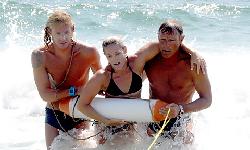
Lifeguards practice during a simulated rescue drill.
No one drowns looking at the ocean.
That's one of the first maxims that a new ocean lifeguard in New York state learns. It's all part of reading the body language of the hundreds of swimmers in the churning surf.
That effort has one goal: keeping beachgoers safe so they never even get close to drowning.
"The scary part of the ocean is, you don't get a second chance," says Bruce Meirowitz, an ocean lifeguard for 41 years and now first vice president of the Jones Beach Lifeguard Corps/New York State Lifeguard Corps, since February, an affiliate of United University Professions, NYSUT's only statewide local. "This summer, we've run thousands of rescues."
No one drowns looking at the ocean, Meirowitz explains, because a panicked swimmer looks back toward the beach and the lifeguards.
An almost indiscernible struggle by two children swimming at Long Island's Robert Moses State Park one recent afternoon in the heavy surf from Hurricane Bill was all it took for lifeguards to interrupt a drill and go into action for real. In less than a minute, the children were on the beach – shaken but safe.
Prevention and safety are the core of the lifeguard's credo, which is in keeping with NYSUT's mission of health and safety. That's why the lifeguards at New York's public beaches and pools want their equipment upgraded, their training standardized and their support services – such as the number of police officers at the beach – on the increase.
For example, Meirowitz said, lifeguards might have gotten to a drowning man two weeks ago at Robert Moses more quickly if a passerby had known how to call for help.
The man had gone swimming in unguarded water; a woman who saw him ran a half mile to a lifeguard stand. Signs posted in such areas with the telephone number of the nearest lifeguard office might help prevent another such tragedy.
The lifeguards see their affiliation with NYSUT as a pathway to improving work conditions and keeping the public safer. Their commitment shows: They train year-round, and many work as lifeguards into their 50s, 60s and even 70s. Regardless of their age or experience, however, all lifeguards undergo strenuous physical exams throughout their careers.
"We're really excited to be hooked up with NYSUT; I know as a teacher the great things we do through NYSUT," says Brian McDonald, a math and physical education teacher at Garden City High School, and a lifeguard for 22 years.
The lifeguards come from all professions, and include teachers, electricians, executives, physicians and firefighters. There are young lifeguards whose parents did the job, among them Brittany Boehm, 24. Her father, Bruce Boehm, was a lifeguard who worked for Cantor Fitzgerald and died in the 9/11 attack on the World Trade Center.
"He taught us about oceans," Boehm says of her father.
And the ocean, in turn, teaches the lifeguards. After they help a swimmer out of the water – be it an intervention or an all-out rescue – the lifeguards "talk about how we did, so we do better next time, because there is virtually no margin for serious error," Meirowitz says. "We're talking people's lives here."
